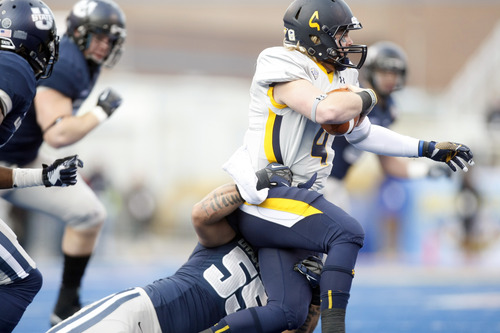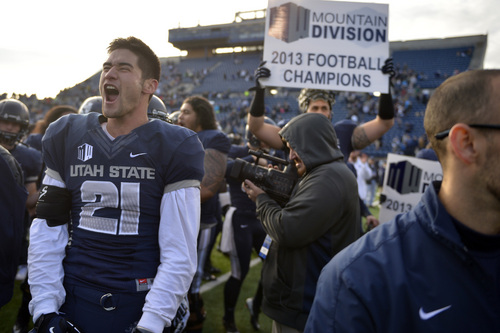This is an archived article that was published on sltrib.com in 2014, and information in the article may be outdated. It is provided only for personal research purposes and may not be reprinted.
With college football completely wrapped from the 2013 season, the numbers are out. And defensively, they're very impressive for Utah State.
The No. 7 ranked scoring defense. The No. 12 ranked total defense. In all, the Aggies ranked among the top 30 teams in 17 different categoies, most of them defensive or special teams statistics, according to a school release.
But here's a question worth asking that has seemed to draw a fair bit of debate: Which Utah State defense was better, 2012 or 2013?
OK, so it's just for fun. But each team has a case. Who would you take: The WAC championship squad of 2012? Or the Poinsettia Bowl-winning team in 2013? Breaking it down:
***
The 2012 Utah State defense
• Better scoring and total defense marks. Although both teams finished the year ranked No. 7 in scoring defense, last year's team did better overall in both points per game (15.4 vs. 17.1) and yards per game (322.8 vs. 330.9). One of the most respected metrics these days is yards per play, and last year's Aggies were better there as well (4.3 vs. 4.6).
• Better pass rush. While this year's Aggies were no slouches when it came to sacking the quarterback, last year's group finished sixth in the nation with more than 3 per game. Bojay Filimoeatu was a big prescence in the pass rush, and having Connor Williams healthy for a whole year helped. Jordan Nielsen had an all-conference season that year. There were just more threats. It also helped the passing efficiency defense (104.4 v. 113.2) which was 10th-best in the nation last year.
• Better in the red zone. The "bend but don't break" mentality was firm last season, especially when it came to stopping touchdowns in the red zone. The 2012 Aggies allowed only 13, as this year's group had 19. The percentages play out as well - that's only a 33 percent conversion rate versus a 42 percentage for this year. Last season's squad only allowed an opponent to get any points in the red zone 63.6 percent of the time, versus 69 percent for this season. Both good marks, but it's a definite edge.
• Spent more time on the field. This may come as a surprise to some folks, but in 2012, opponents had the ball for an average of 32 minutes a game. In 2013, that was only 28:47 minutes. It has a little bit to do with how effiencient the USU offense was — basically in 2012, they were zooming down the field in not much time. So a season ago, Utah State had to be on the field for three more minutes per game, but they still managed to have better overall total defense and scoring defense marks. Good work.
***
The 2013 Utah State defense
• Faced better competition. This year's crop of Aggies faced way more bowl-bound teams (7 this year vs. 3 last year) thanks much in part to playing in a better conference. That included holding the two best-ranked offenses the Aggies faced - Fresno State and Northern Illinois - to 24 and 14 points respectively, both season lows at the time. In all, the Aggies faced four top 25 scoring offenses this year, and shut out one of them (Colorado State). Last season, the team faced one such offense (Louisiana Tech) and gave up 41 points. Utah State didn't give up that many points in any game this season.
• Better run defense. The Aggies gave up 106.7 rushing yards per game this year, and didn't buck from that too much. Utah State did give up more rushing touchdowns, but no rushing touchdown was from more than 10 yards out - fewer explosive runs. In all of the season, opponents got only six runs of 20 yards or more against Utah State. What's most impressive is that statistic came despite facing three of the top 10 rushing offenses in the country (New Mexico, Northern Illinois and BYU).
• More turnovers forced. This year's group had 17 picks and 13 fumbles recovered, which helped the team get a 19th best turnover margin with a plus-11 mark. It was a team effort: 10 different Aggies recovered a fumble, and 10 different players caught interceptions. Brian Suite and Nevin Lawson helped lead the picks with nine between them. The 2012 defense had 20 takeaways, with only six fumble recoveries. Somewhat related is three-and-outs: This year's group forced them on more than 45 percent of drives for 5.57 three-and-outs per game, eighth-best in the country. Last year's group forced 5.08 three-and-outs per game.
• Supported a less prolific offense. The Aggies boasted the No. 25 scoring offense in the nation last season, but only the 50th this year. In the latter half of the season, when the offense was dealing with season-ending injuries to its starting quarterback, running back, tight end and one of its guards, the defense had to help carry the load. They accomplished that with defensive touchdowns - it's going to be hard to forget Kyler Fackrell's 99-yard pick return or Jake Doughty's fumble recovery for a score - and setting up short fields. Defense helped spur the Aggies to wins against Colorado State and Wyoming, and also helped keep the Mountain West championship game close. When Utah State's offense was sputtering against Northern Illinois in the Poinsettia Bowl, defensive stops and turnovers kept the Aggies in position until the game-winning drive in the fourth quarter.
***
You have an opinion? Is there a consideration being left out? Chime in on Twitter or on the comments below.
— Kyle Goonkgoon@sltrib.comTwitter: @kylegoon







